Varosha had been a ghost town for almost 50 years when the Turkish-backed government of Northern Cyprus unilaterally decided to reopen the former beach resort to tourists. Once a fashionable destination for the likes of Brigitte Bardot and Elizabeth Taylor, Varosha had remained sealed off as a militarised zone and untouched since the Turkish invasion of Cyprus in 1974. The move to “resurrect” Varosha was controversial but Varosha proved irresistible for excursionists.
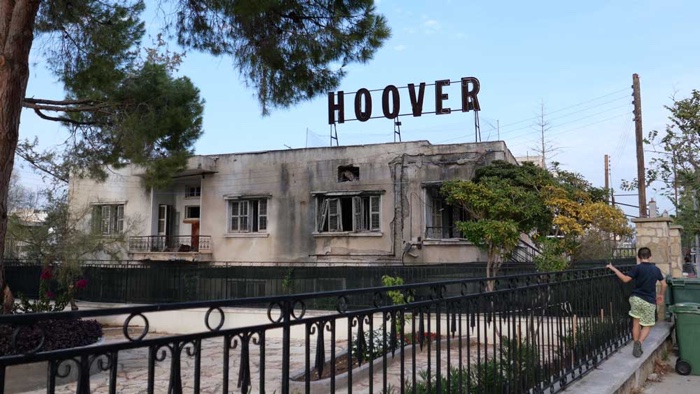
Rose Butler, Postcards from Varosha
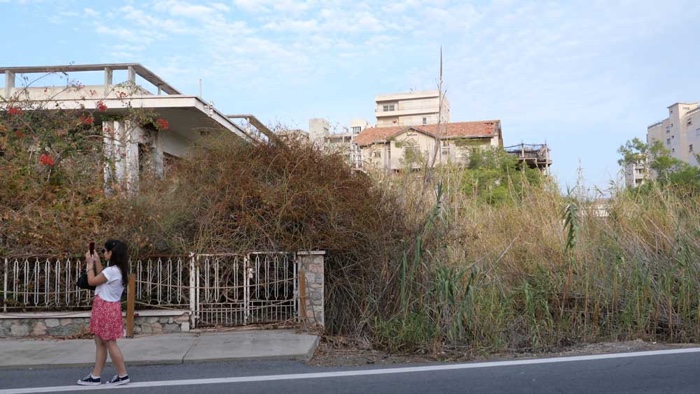
Rose Butler, Postcards from Varosha
Artist and researcher Rose Butler visited the policed borders of Varosha shortly before its reopening. She later invited artist and film maker Kypros Kyprianou as well as artist researcher and lecturer Jeremy Lee to visit the new tourist attraction with her. The result of their collaboration was exhibited at NeMe at Limassol in Cyprus until a couple of weeks ago.
UNLAND presents both documented and fictional material of the Cyprus buffer zone, Varosha and British military bases, as well as areas located in the line of separation where communities from both sides of the border engage in activities such as common grazing grounds and mixed farming. While some of these spaces are defined by rigid military and surveillance architecture, others straddle areas of leisure, nature reserves, tourism, farming and decommissioned zones. The aesthetic qualities of these areas almost contradicts the violent history and militarisation.
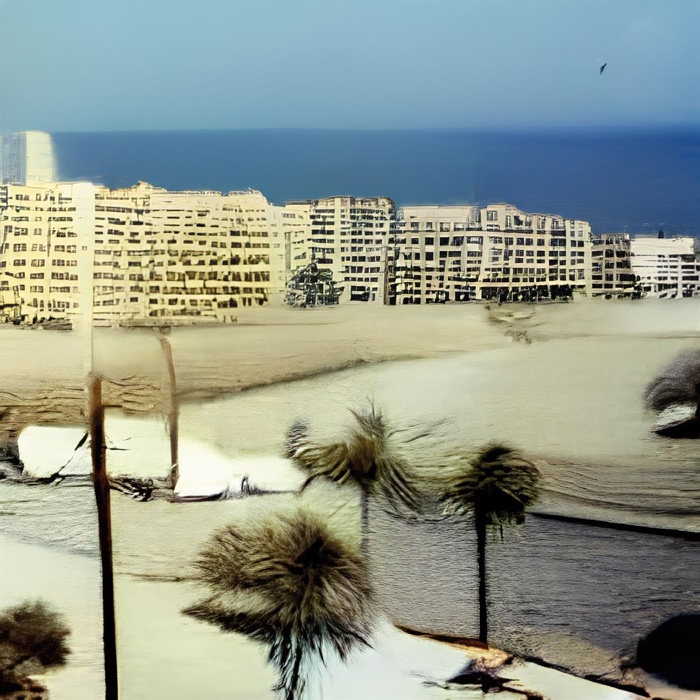
Kypros Kyprianou, News from UNLAND (Famagusta, Cyprus in 1974), 2023
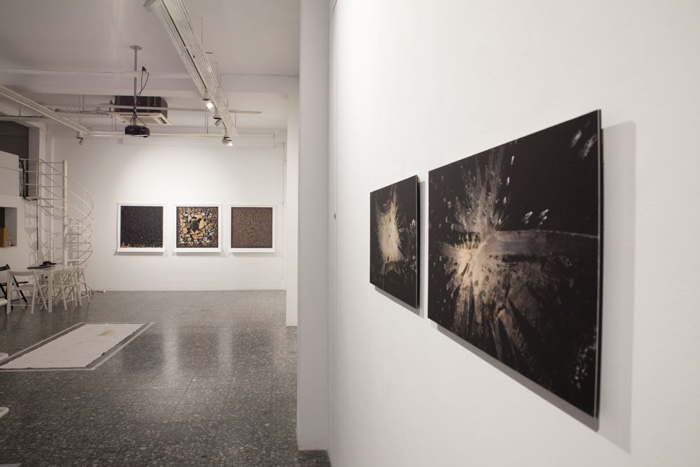
UNLAND. Installation view at NeMe. Photo by Jafra Abu Zoulouf
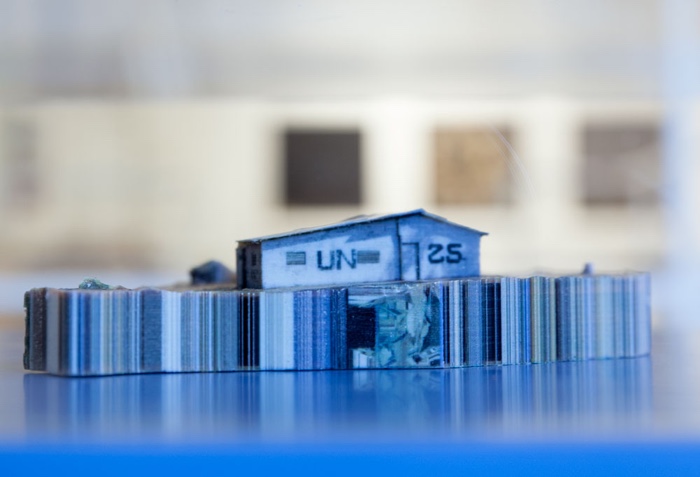
UNLAND. Installation view at NeMe. Photo by Jafra Abu Zoulouf
Rose Butler and Jeremy Lee used photography, video, Lidar scanning and photogrammetry to explore the spaces, navigating first the lockdown and travel restrictions and then, once on site, a series of filming constraints. Kypros Kyprianou worked remotely, using online archives, mapping and machine learning.
With their use of high resolution and forensic technologies, the artists didn’t intend to give a surgically precise representation of the places. Instead, these technologies complicate these areas, making emerge different types of borders but also the sheer difficulty of recording and representing complex sites through imagery. Each in their own way, the work present nuances and contrasts. The high-resolution is accompanied by messy, glitchy data. The ghosts rub shoulders with sightseers on bikes. The derelict war zone coexists with hedonism, the past with the present.
Rather than enhancing the ‘quality’ of the images, technologies expose the gaps and flaws. Through this, they present the overlooked, beneath the surface, hidden, accidental or malfunctioning manifestations of ‘visioning.’
Rose Butler, Look At Those Palm Trees, 2019
My first question is about the access you got to the locations that UNLAND investigates: the Cyprus buffer zone, Varosha and the British military bases. How difficult was it to work in these spaces? Did you have to get special permits? Did you encounter many restrictions?
Rose: In 2019 there was still no access to Varosha and you could only walk to the edge of ramshackle fences – one in which disappeared into the sea. Look at Those Palm Trees (2019) was documented at this time. Initially, I intended to use Lidar to document from the edges and I was particularly interested in Varosha. Lasers hitting objects, surfaces and areas related to the military to create hollow shell like forms seemed an appropriate technology to consider spaces that are empty, inbetween, restricted or in stasis.
This formed the basis of the project and it seemed obvious to work on another project with Kyp who is UK Cypriot and Jeremy who specialises in Lidar and photogrammetry to make work.
We submitted a request for access as researchers within the buffer zone and originally we intended to explore this with a UN escort and documentation permissions. The pandemic presented all sorts of new barriers, the biggest being travel restrictions, and then university travel restrictions and the temporal barriers that having a child in tow presents as we tried to fit around school holidays.
In 2020, as part of the election campaign in Northern Cyprus, a small area of Varosha was opened to the public for the first time since 1974 (when Turkey invaded following the Greek Junta organised coup). In the same week as we prepared to go out during October half term, Boris Johnson announced the possibility of a ‘circuit breaker lockdown’ and so we cancelled our trip. By the time we managed to return to Cyprus in October 2021, Kyp was not able to travel and political tensions meant that access to the buffer zone was not granted and so we revisited Varosha on this trip. NeMe supported us in also exploring the different areas of ‘edgelands’ in and around the buffer zone and military bases and arranged a visit to the Atsas olive farm situated within the buffer zone.
The areas that we filmed within did not require permits or permissions, apart from Atsas farm. But these spaces feel patrolled, surveilled, hostile, militarised and threatening. The restrictions imposed are self-imposed. I think the sense of surveillance is much more present through the impact of digital media and the everyday pervasiveness of surveillance technologies. At these sites and throughout Cyprus the architecture of buffer zones, restricted areas and surveillance is all around including the patrols of the UN and the manoeuvres of the British, Turkish, and Greek Cypriot military.
As a camera person I am acutely aware of the parameters of filming in sensitive spaces. Filming can offer potential as well as making yourself more visible and potentially vulnerable. The camera can act as a prop to prompt on-the-ground and situated conversations, it can open doors, provide insights or sometimes gets shown around so that what you document is through the ‘eyes of others’. In more sensitive areas the decision about whether to put a tripod up is an important one. A tripod can suggest ‘professional’ but it can also make yourself so obviously visible that people are not threatened by the possibility of covert filming. As I documented at Varosha I was asked several times by the Turkish police if I was a journalist – purely because of the tripod, despite the fact that documentation is actively encouraged and the whole area is saturated with documentation and selfies. Saying that I am an artist sometimes offers some reassurance. However, we did not feel comfortable enough to use the Lidar scanner, it is obviously not a camera and could cause concern – I didn’t want to risk it being confiscated. Jeremy worked with photogrammetry instead.
At the Atsas farm, we moved between the UN patrols when filming the abandoned UN post, so restrictions were temporal and filming sometimes on the fly. For me, the quality of documentation does not reside in high resolution or perfection (good job) but on filming no-matter-what, if I can, to explore access, boundaries, prompt conversations. Sometimes what you cannot see reveals more than the image itself.
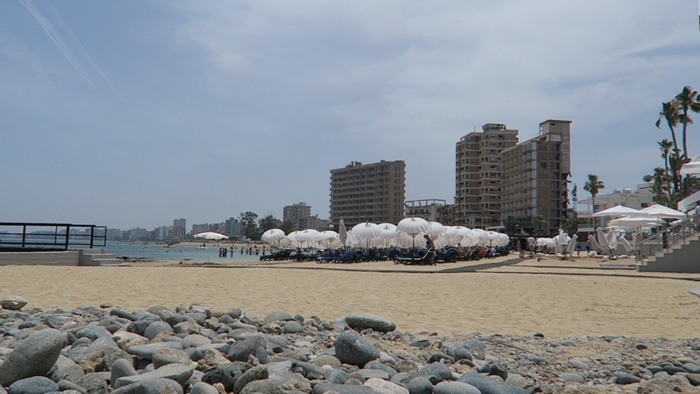
Rose Butler, Look at Those Palm Trees (film still), 2019
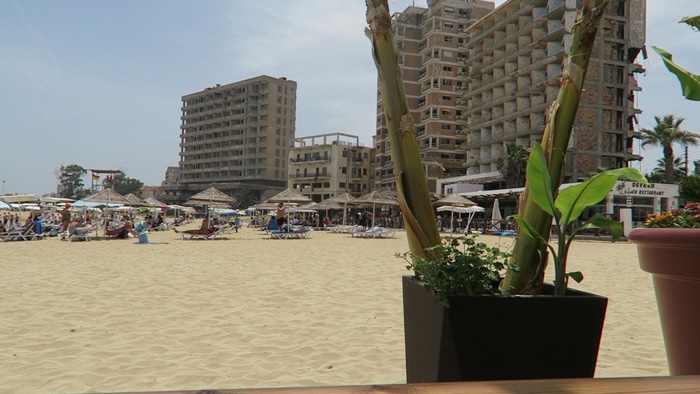
Rose Butler, Look at Those Palm Trees (film still), 2019
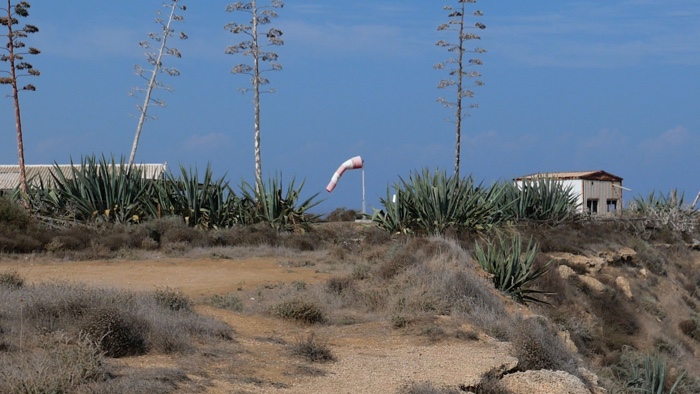
Rose Butler, Island of Space (film still)
Why did you select these 3 spaces and what is their individual role or significance within the project?
Rose: The buffer zone is porous in places, mutable, expansive in some parts stretching from anything between 17 miles and 3 metres in distance. But beyond the buffering of the cease-fire line in Cyprus are many other geopolitical restrictions, edges, boundaries and players. Cyprus has been referred to as an ‘island of space’ in a US congress bill, as a de-facto US special intelligence colony. Both visible and invisible technologies permeate the territorial island – from fighter jets setting off to Syria, to key Five Eyes listening stations. Layers of historic colonisation accrete with layers of technological colonisation.
The three areas -Atsas olive farm in the bufferzone, one of the British military bases where the Five Eyes listening station is situated and Varosha, an area that is occupied by the Turkish military, are three areas serving or existing within different political tensions beyond the buffer zone itself. The work also roved around different areas alongside the buffer zone such as the abandoned UN post at Paralimni and Kyp’s AI work which explored areas of Nicosia as well as spanning the whole island.
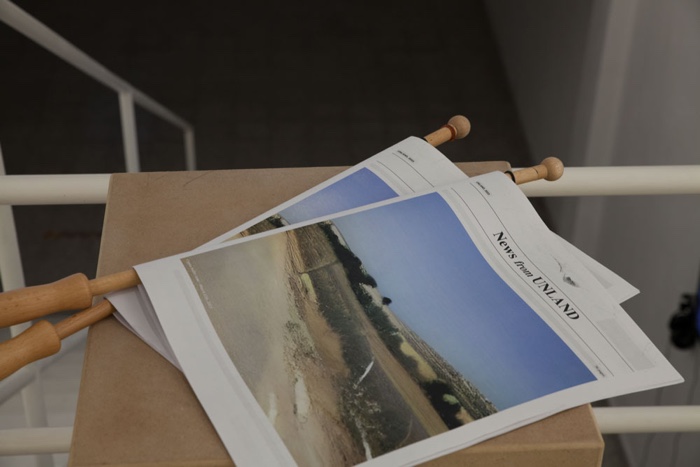
UNLAND. Installation view at NeMe. Photo by Jafra Abu Zoulouf
Kypros: The types of division mean there are different fragmentations, Cyprus is all of these fragmentations. And they all have their own ‘time’. The buffer zone in one place cuts through Nicosia, the only divided city in Europe and the only divided capital city in the world. It can now be crossed in places but it splits an ancient walled city, people live and work right up to the edges of this zone, it’s highly visible and changes how one navigates as a visitor and where one lives. Of course, water, electricity and sewage pass through, the infrastructure is necessarily shared as it always was.
Each of these places is occupied or Occupied in different ways. One space is a capital city sliced through in very close quarters rendering a centre into a dusty periphery in places, one is a tourist town that has laid empty as a bargaining chip, now partially reopened as part of a weird disaster tourism attraction. Another is a British crown colony, colonialist history with a present through-road. It’s an archaeology of occupation.
The significance for me is also that for UNLAND I never managed to get to any of these places physically in the end. But you can now fly over them or drive up to them virtually, which given their status is weird – although of course, sensitive details and resolution are erased in the case of, say, flying over army bases in Google Earth, so there’s a layer of fiction in there too.
I was at a distance both physically and in time/memory. In the past I had a few significant encounters at the buffer zone in Nicosia, some interactions with British soldiers on and off Sovereign territory as well as ex-soldiers in the UK who had been stationed in Cyprus. In the past, I have stood on the edge of the buffer zone scrub watching Famagusta slip into darkness at sunset. I travel through the road corridors of the British Sovereign territory, where a message on a mobile phone about roaming charges feels like a bit of technological sarcasm. – The British military bases are a legacy of the Crown colony of Cyprus. They are British Overseas Territories, so the electromagnetic spectrum is colonised as you travel through them, mobile phone messages signal the beginning (or end) of roaming charges. The British were meant to pay the Republic of Cyprus for the use of the roads connecting the locations of the bases but, of course, they don’t. In the News from Unland newspaper I made, one of the captions from a historic image makes reference to the frustration at lack of payment. Feeding this into a text-to-image machine learning program resulted in an image of some people in hard hats holding up a giant comedy cheque. AI at least statistically has a sense of humour.
The only place I went to in any of the work we presented was in the ‘journey to the centre of’ piece, going to what google earth deemed the centre of Cyprus, at first from millions of miles away in space, to eventually arriving at the coordinates and filming myself touching the ground there.
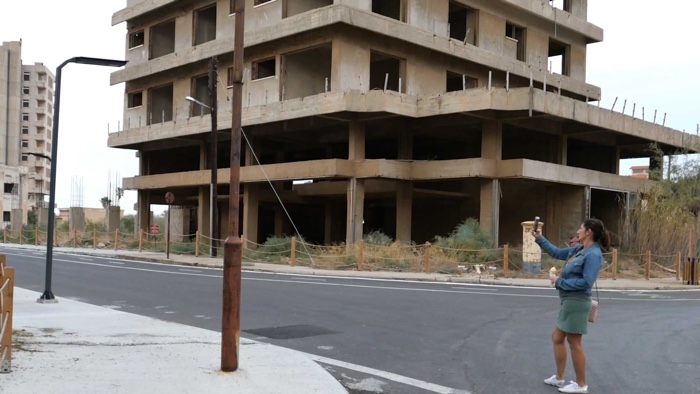
Rose Butler, Photographs from Varosha (film still)
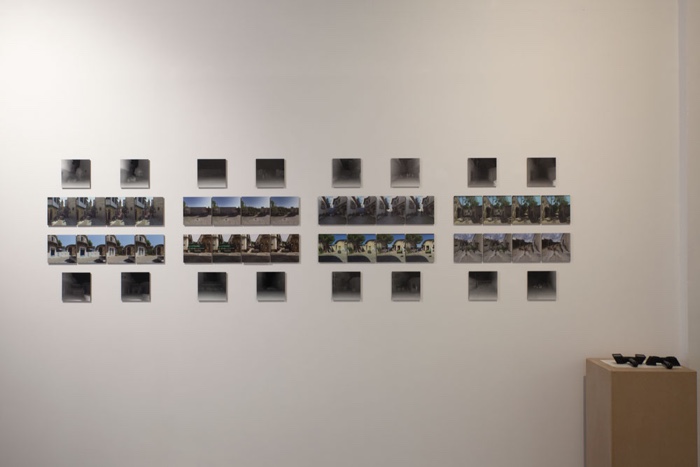
UNLAND. Installation view at NeMe. Photo by Jafra Abu Zoulouf
Could you tell us about the title of the work, UNLAND?
Kypros: We had gained permission to visit particular buffer zone areas, then the pandemic hit. Covid regulations scuppered us on more than one occasion, and I couldn’t go to Cyprus for a variety of reasons, so it began to feel like I would be never going back to my ancestral lands. I had started using Google Street View to look at areas where it went right up to the buffer zone in Nicosia. There’s lots of signage everywhere when you’re trying to drive a virtual street car there, so I was sort of aiming for these UN signs. Meanwhile, Jeremy and Rose had been over and sent what they had documented, including areas around the buffer zone, so their photos and model textures also had these capitalised words everywhere… UN… UN… UN… so it started feeling appropriate for the fact that we were trying (and failing) to get to this bit of (UN)LAND.
Rose: I am interested in buffer zones / patrolled zones such as the death strip in former Berlin, and sites of stasis resulting from militarised zones and borders. Originally I thought of this ‘space’ as the space between film stills that makes the illusion of moving image work – as the film strip travels through the projector, the gap appears as an unperceivable black space of 1/48th of a second. Stasis conjures limbo and expanse, I am interested in how a space in limbo, transition, mutability of neither being here or there supports highly defined spaces of control. UNLAND suggests that the buffer zone is land that is not land.
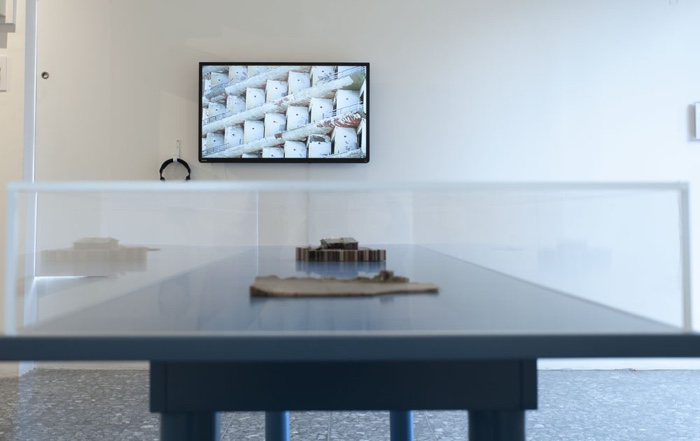
UNLAND. Installation view at NeMe. Photo by Jafra Abu Zoulouf
The exhibition presents both documented and fictional material of the Cyprus buffer zone, Varosha and British military bases, as well as areas of bi-communal activity and farming. Why does fiction bring to the work? What does it flesh out or reveal that technology and facts alone cannot communicate?
Rose: Fiction is an important part of researching and getting to know a space, culture or history. I like to read novels that capture historical, personal and political narratives when I am working somewhere that I have not been to before. Normally I would carry out more field trips and read whilst travelling. I find that literature can provide a way into the work, introduce you to spaces and places, I enjoy the very real overlap and coincidence of on the ground experiences and the fiction that I am reading. Whilst working in Berlin at the Stasi Archives on a previous project, it was amazing to read Orwell and Solzhenitsyn, censored radical ghosts that accompanied me on my understanding and experience there. In Cyprus, I read Elif Shafak’s new book – The Island of Missing Trees, I was amazed by details of conversations that overlapped with ones that I had also had. Her book also expanded thinking around migration, details about flora and fauna and the poetics, romantic, organic, cultural and historic undercurrents of places. Normally with the possibility of more field trips I write field notes that combine my experiences, encounters, literature, media reports, and things like social media feeds. I think of this as attempting to capture the atmosphere of a place, being somewhere in particular at a particular time really emphasises the impossibility of ‘capturing’ a place through imagery.
Kypros: The fictions in some of the pieces, such as the stereoscope series Unland Imaginaries in particular, are what I would call documentary by other means. The fiction is a sort of time travel, forward or back into past or future memory. They all begin as scenes where the buffer zone intersects a street and so has walls of various types in it, where normal life has withered and this paraphernalia obstructs us visually as well as impedes any movement. Every Turkish Cypriot and Greek Cypriot I know wants these barriers removed somehow, want them to disappear. I had been reading interviews with refugees who had once lived in the Nicosia buffer zone, who have lived with this situation. I used these transcripts as phrases inputted into machine learning programs to paint into the scenes captured and stitched together by Google StreetView. The fiction points not to what it is, but perhaps to what it was, to what it might be, to what it will be.
In the News from Unland piece, it’s sort of a fictional newspaper and sort of not. The fictional works rely on technology to investigate memory. In one sense it’s a way of reconstructing memory. If we consider that machine learning (ML) is a sort of ‘Memex’ as envisioned in 1945 in As We May Think by Vannevar Bush – a way of storing all the books/ records someone has -‘an enlarged intimate supplement to (our) memory’. The News from Unland takes the captions of historic newspapers scanned online and makes new images just from that text as an instruction, but the model in the background that does that, will likely include the very same images and text that I manually looked for online.
The image generation is done by models that trawl online images, the same online space we increasingly use to navigate in the real world- as maps or historical information in the case of the pieces I made. These scenes are each ‘memexs’, and the constructed scenes generated as a contraption of fiction, fact, memory, model, web scraped databases, labels, techniques.
From what people have said there is both a nostalgia to some of the series of stereoscopes and the newspaper piece, a sense of a past, but also a yearning for a future, so the fiction, like science fiction oscillates between past present and future.
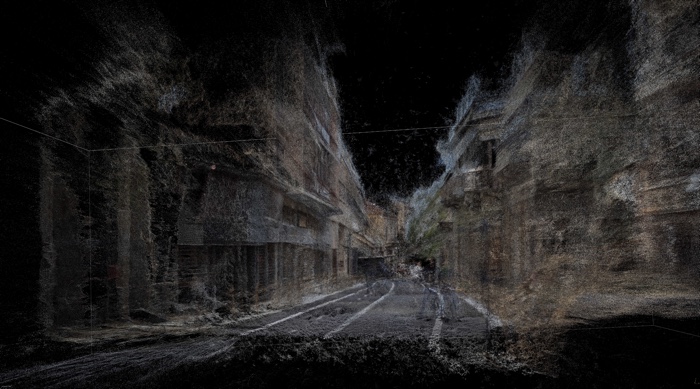
Streets in Varosha, 2022. Photogrammetry courtesy of UNLAND
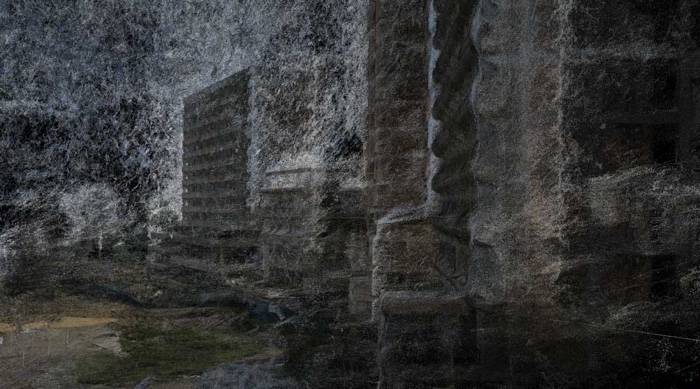
Varosha Beach, 2022. Photogrammetry courtesy of UNLAND
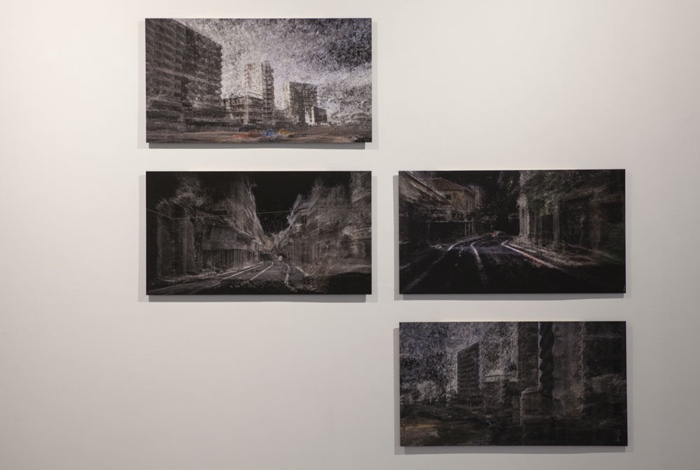
UNLAND. Installation view at NeMe. Photo by Jafra Abu Zoulouf
For some of the artworks that are part of UNLAND, you used photography and video but also Lidar scanning and photogrammetry. How did these technologies help you apprehend the spaces differently?
Rose: Technology can both extend and limit what we can see. As artists we extend the use of technology beyond its intended industrial use, moving it away from its often militarised history and applying its use creatively. But we can also use devices performatively like a prop. For example, a camera on a tripod often invites discussion, or carrying a camera can present the opportunity to be shown things to document.
Lidar is a forensic technology, once a scan is complete and used to create a 3D model, the apparatus is then unanchored from a fixed point of view. This means that it can look over, above, around and through walls or barriers, or can be positioned within a buffer zone that we could not access.
But we were also interested in the flaws in technology. What does messy data generate and allow us to see, how can these minor, poor quality, accidents present different insights and experiences? Does this help us have an experience of somewhere or something that moves beyond an encounter with an image or an artwork? Does it expose visually the flaws, biases and faults in data collection and analysis that we know is rife but cannot see?
Higher resolution, high tech and extensive surveillance does not necessarily mean better information. The flaws, faults, minor, messy or failed within situated on the ground experience perhaps offers different, nuanced and detailed information.
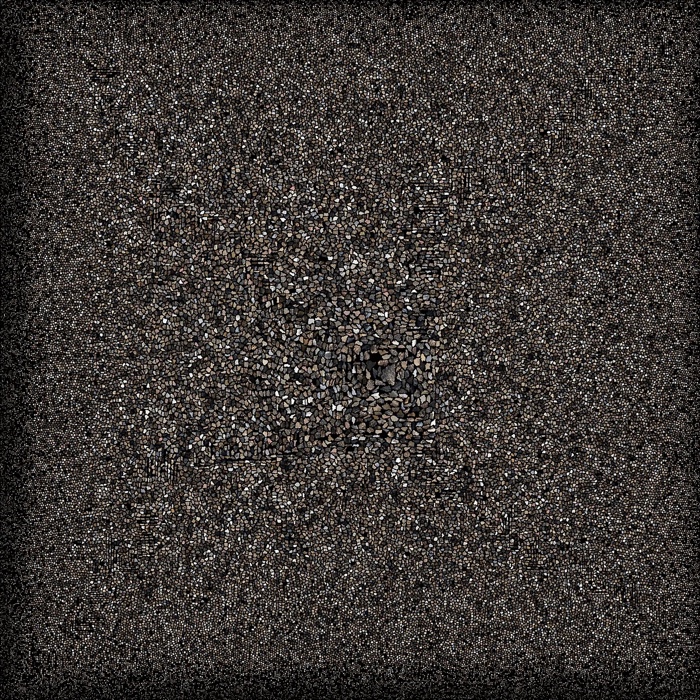
Jeremy Lee, White plastic chair discarded by the sea edge on the rocks adjacent to the buffer zone, someone might have being using it whilst fishing
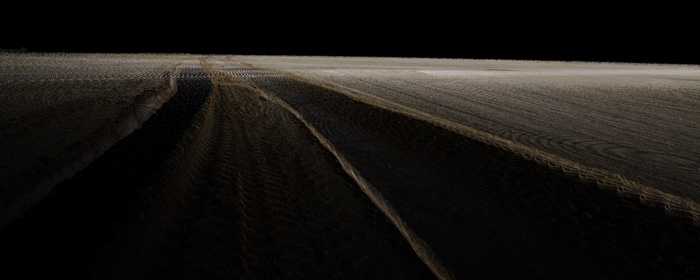
Jeremy Lee, Salt Lake, 2023
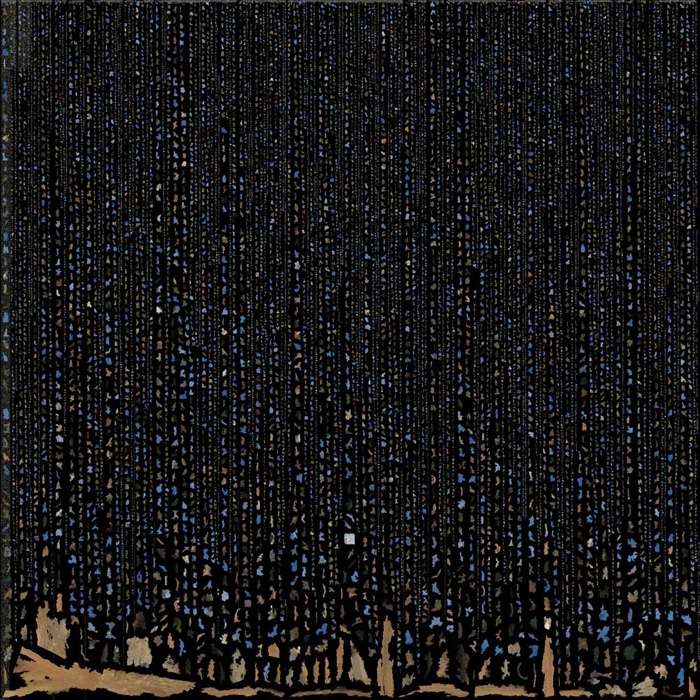
Jeremy Lee, UN oil drums and large cactus plants in the buffer zone next to a decommissioned UN post, 2023
Jeremy: Part of my work and research over the past 15 years has used Photogrammetry and Lidar as these are employed in the visual effects community to quickly capture elements of landscapes and townscapes for filming and compositing processes alongside these technologies being primarily designed for use in engineering and forensics.
Using these processes, you are able to capture the surface of an area of landscape or street, this can then be manipulated in 3 dimensions, so you are able to view from any desired point of view within the point cloud of data this enables a kind of virtual omnipresence within the scene captured.
Typically, the normal preferred end result for these scanning processes is a clean polygonal mesh or virtual copy if you like of the scene, so as to fool an audience in a commercial film.
From the work I produced previously and in the work for exhibition Unland, I have been looking at the in-between, hidden processes not normally shown, the mistakes the algorithms create, the machine eye and the messy or incomplete data the computer creates. This can be confusing and beautiful, the machine not caring about and this just following a set of orders to complete a task. This is shown in the texture maps presented, the rules are to fit the texture map of a given 3D object into a 1×1 2D space. The computer does not care about beauty or human comprehension, it wants to fit all the texture into this space in the most efficient way using all the space available but not overlapping.
For us this creates an abstract largely incomprehensible image with small understandable elements: a landscape torn into a thousand pieces and presented on a canvas.
Within Varosha we were unable to use the Lidar as this looks like a formidable piece of possible spy equipment, so I used Photogrammetry taking thousands of images hoping the end result would give us something to work with – it is not always a certain process. Fortunately, this worked for me (it wouldn’t have for a film crew).
The point clouds produced were messy and confused, capturing the sky as solid areas in wrong positions. This for me enhanced the strangeness of this place, a sepulchre of sorts holding the memories of past inhabitants. The two fly throughs show my possible intent as you pass through the dream-like cloud – areas focus, glitch, break up become confused as in a memory of place. It brings to mind the term “Ghost in the machine” which was used originally by the philosopher Gilbert Ryle as a critical comment on the notion that the mind is separate to the body. But I do romantically enjoy the notion of this phrase attached to the machine eye or computer vision processes.
In the exhibition, there are also small 3D printed photoreal models produced with the same photogrammetry data. Shoes on the Salt Lake, an abandoned UN building and UN marked oil drums. These give an end to the process of capture, a small to-scale diorama of the focused subject, turning it from the abandoned to the collectable and precious, a hyperreal model view, for me a Hornby (model railway) enthusiasts obsessive view (not that I am).
I think this runs through the whole of the exhibition with Kyp’s stereoscopes building stage sets of views of the border, or his AI newspaper or with the Varosha video tours being like a weird disaster experience in an apocalyptic film set.
Rose: Models are also interesting prompts for imagination, play, visualisation, future projects but also the nostalgia of lost childhoods.
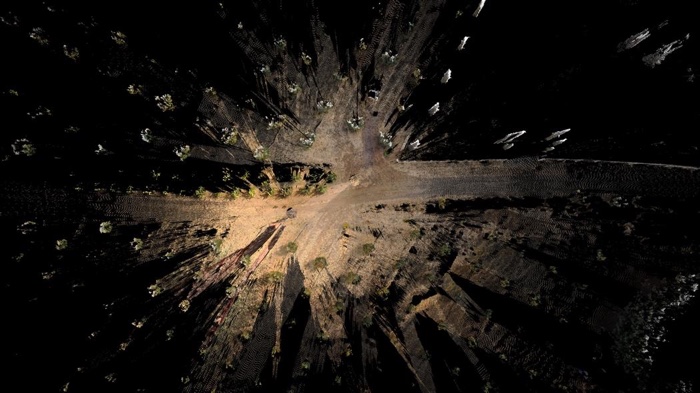
Atsas olive oil farm situated in the UN buffer zone, Evryhou Solea Valley, 2023
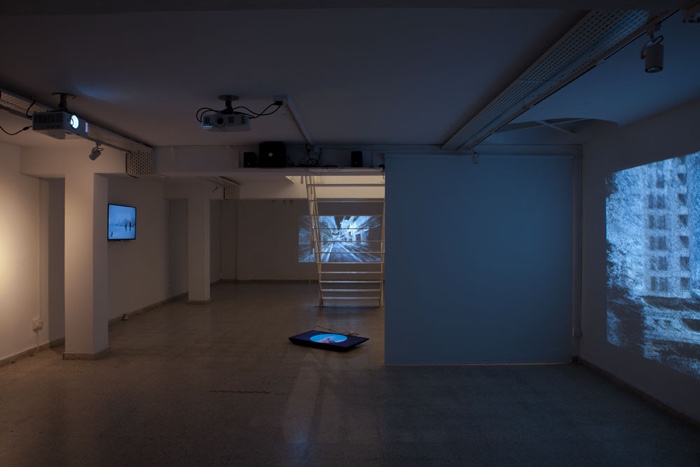
UNLAND. Installation view at NeMe. Photo by Jafra Abu Zoulouf
If I understand correctly, Rose visited the policed borders of the seaside resort of Varosha before the area was opened for tourism. And you went back again after the pandemic. How did the area and the way you approach it change after it was opened?
Rose: It was a very different experience. On my first visit in 2019 it was the first time I had travelled into the northern part of Cyprus. I hired a car with a friend and we approached the area as tourists. There is a hotel on the beach and several bars, the border that ran across the beach and into the sea was made of old fencing, bits of metal and an old boiler. There were many tourists using the beach and there was a stark contrast between the leisure on the beach and the abandoned remnants of a war zone behind. There was a steady stream of people walking to the edge of the barrier that cordoned off the area. There were some UK Cypriots as well as Greek Cypriots who reminisced, gazed, and told stories of their familial and personal history and connection to Varosha.
When I returned in 2021, there was an entrance behind the sea front that was very busy with predominantly local and international visitors. There was a greater policed presence and many signs about documentation being allowed excluding drones. On entering the area and going through a brief bag check there was a cafe and a place where you could hire bikes. There was now 10km of the resort opened and you could cycle along streets behind the beach front. At either end of the beach front there were mobile cafes and a large central cafe in the old Hoover building, with makeshift toilet facilities. Some of the roads had been re-tarmaced, islands had been replanted and a small bus carried tourists back and forth. The mosque was in use and had been partially renovated. The beach at the far end had been populated with sun loungers and it appeared as though there was a bar for the Turkish military on the sea front.
In 2023, you could hire electric scooters and golf buggies, as well as taking the bus tours and hire bikes. The cafe on the beach front had turned into a large marquee, two extra sections of the beach had opened to tourists, there was significant building works around the mosque and information boards about ownership and historical deeds had begun to appear next to significant buildings. The UN had a greater presence than previously and I was more aware of their bases on the site. At the beach at the far end there were more sun loungers, a cafe and a playground.
Between the visits my approach had changed from one of semi-naive tourist to one of researcher. The way that I ‘looked’ changed and, as I became more informed of the political situation and tensions, the way that I approached the work and area shifted. It is difficult to feel critical whilst being implicit as a tourist in this incredibly evocative, intriguing and resonant space. I think it is important to witness and experience, to have or generate dialogue. Works may act as prompts around incredibly complex political spaces. Documentation can sometimes reveal things about an area by the very nature of carrying it out as well as its subject. On my recent trip I began to look more closely at detail and signage, of names and information.
The work Unphotography uses machine learning to recreate an incident from almost forty years ago when Kypros was prevented from taking a photograph of the buffer zone next to a sign that said ‘no photography’. Why did you want to use ML to bring that moment back? What was the result and what did you learn from that experiment?
Kypros: WHY…
It was a development from the feel of working with ML on the other work I was doing. For the News from Unland piece in particular a couple of significant historically well-known images and the story behind them made me question assumptions, things that I thought I knew. I had also been making the stereoscope pieces which involved examining the buffer zone in Nicosia, some of which looks like it hasn’t changed since 1974, in other places though is unrecognisable. The research in the work for both of these use machine learning. And both of these pieces intersected with a specific quite visceral memory of my own. My relationship with that memory has changed. I started asking questions. What can I really remember? Was the U.N. soldier reading the Beano or another comic? Was his rifle sling on the floor or leaning against a bit of blue and white painted chipboard? How old was the cafe owner? How did he get my camera off me? What happened to the roll of film when he ripped it out? Is it in the telling that it has changed? What other rememberers are there out there? Can I find a photograph of the buffer zone at the time when this took place to help me put this memory back together?
As I’d been using ML to try and put together both other people’s memories as well as newspaper archive ‘memories’, it led me to wonder what ML and its models would be able to do for my own – could it help in reconstructing a moment when an image was lost?
WHAT I LEARNT…
What I learnt from doing this was that the tiny amount of change resulted in big shifts at what the model gave me. I was trying to put together a moment, and had to put together bits of the moments that led to it. Trying to describe it all at once was hopeless, so I ended up trying to do it as a series of bits – like what my eye could focus on a bit at a time. There was a performance going on between the general and the particular. I was wrestling with the ML model and trying to get THE image out of it, then realised I could only get a flow of potential pieces, a sequence, and that wrestling was the same as the moment when the actual cafe owner wrestled the actual film out of my hands, so in a sense I did recreate the scene – the emotion of it anyway – in the making of it.
I imagine that the Cypriot audience might have a complex relationship with the spaces you worked with. Could you already tell us something about the kind of conversations the works generated during the opening of the exhibition in Limassol?
Rose: This was a concern during the making of the work. I was sensitive to commodification of these sites through disaster tourism in which I was implicit within. We were all aware of finding imagery that was representational in a way that went beyond turning warzones into art works, or that only displayed the undeniable beauty of abandoned unpopulated spaces. This is why the type of technology and technique I use for documentation is so important. Technology brings its own material qualities to the images we present and has politics embedded within those qualities. Whilst I carried out doctoral research I observed the Investigatory Powers Act (2016) – digital surveillance legislation as it passed through the Houses of Parliament. I took photographs on a 1960s analogue Minox spy camera as a way to explore access, barriers, looking, visioning in a way that wasn’t centred on high resolution data.
The exhibition opening had a predominantly Cypriot audience with a mix of international artists who lived in Cyprus. The works were very triggering for some people who could see their properties within the footage. Some people were emotional, others were moved and some angry at the political situation. I was thanked several times for the exhibition, for bringing the images to an audience. We talked about the histories of the people who had been forced to flee. In 1974, 37,000 people fled overnight into the fields of Famagusta expecting to return.
The works also prompted many questions around technique, materials, whether the photogrammetry / Lidar was photography or whether we were photographers. We were also lucky to be able to give a talk as part of Data for Care at Neme. This brought an international conference audience and we expanded discussions around technology, data, politics, AI and surveillance.
Kypros: From more than one conversation (my Greek language skills are rusty) there was a sense that it was both quite stressful but also in some ways cathartic. One relative of mine, born after 74, spent a long time looking at the stereoscope series which depicts the Nicosia buffer zone from north and south, and real and imagined. He put his hand up to his face, and held his breath and made a fist on his chest. Then he was saying that everyone was so close and living with it forever that it was so in close up that you couldn’t see, you couldn’t breathe. Then he let out a long exhale, pushed his hands away and said UNLAND gave him a way of seeing it from further back. Like he’d travelled too.
Thank you Rose, Kypros and Jeremy!
UNLAND was exhibited at NeMe in Limassol, Cyprus on 18 April-10 May 2023.
